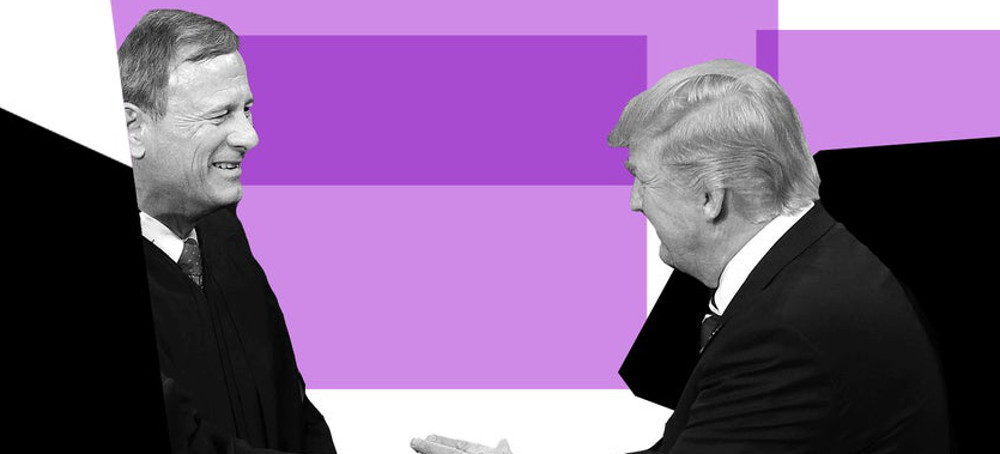
07 July 24
We are in the process of the second American Revolution,” Heritage Foundation president Kevin Roberts thundered on Tuesday in celebration of the Supreme Court’s decision granting Donald Trump, and all future presidents, sweeping immunity from prosecution. This judge-led revolution, he added ominously, “will remain bloodless if the left allows it to be.”
Kevin Roberts is not alone in cheering the Supreme Court’s hard turn to the right as a de facto revolution. The New Civil Liberties Alliance, a far-right group that welcomed coup abettors into its fold, trumpeted that “the dismantling of the unlawful Administrative State has officially begun” after SCOTUS overturned the 40-year-old doctrine of Chevron deference.
Republican officials, commentators, and activists are jubilant over the court’s recent rulings, applauding them as the dawn of a new era in American governance. And they’re not wrong. While Democrats fret for a second week over the fallout from President Joe Biden’s disastrous debate performance, many Republicans seem to feel as if they’ve won already, entrenching many tenets of Heritage’s Project 2025 into law before a single vote has been cast.
The GOP’s triumphant attitude is neither premature nor overconfident. Four months out from November, the party has abruptly prevailed in many of its most important political battles, albeit in the cold, technical prose—you might even call it “bloodless”—of judicial opinions.
The Supreme Court’s conservative supermajority has, in recent weeks, restructured American democracy in the Republican Party’s preferred image, fundamentally altering the balance of power between the branches and the citizens themselves. As the GOP became the party of coup denialism and unreconstructed Trump cultists, so too, finally, have the sober movement conservatives at the high court.
In the course of its most recent term that conservative supermajority has created a monarchical presidency, awarding the chief executive near-insurmountable immunity from accountability for any and all crimes committed during a term in office. It has seized power from Congress, strictly limiting lawmakers’ ability to write broad laws that tackle the major crises of the moment. And it has hobbled federal agencies’ authority to apply existing statutes to problems on the ground, substituting the expert opinions of civil servants with the (often partisan) preferences of unelected judges.
All the while, the court has placed itself at the apex of the state, agreeing to share power only with a strongman president who seeks to govern in line with the conservative justices’ vision.
Someday historians will manage to explain why the same Roberts court that declined to rig the 2020 census in favor of Republicans, declined to intervene in the bogus 2020 election fraud cases, declined to rubber-stamp a wholly fabricated “Independent State Legislature Theory,” and refused to protect from investigation Trump’s personal papers and advisers made the sharp turn in 2024 to become his handmaids.
At some point the rumors that there was a 3-3-3 court with a careful and moderate center became simply laughable, and those same “moderate” justices made the decision that whatever impulse toward public legitimacy had constrained their conduct in recent years was for suckers: Having taken on far too many high-profile game-changing cases, the choice for the 2023–24 term was go big or go home. They went big.
And make no mistake about it: When a court that has been battered by near-weekly reports of undisclosed oligarch-funded vacations (and gifts and super yachts and tricked out RVs and secret conferences with high-paying Koch supporters getting access to justices) decides to make it easier to bribe public officials—as it did in Snyder v. U.S.—that’s a very public signal that the conservative supermajority does not care what you think.
When a court that has been caught with not one but two justices who have spouses who were excited by insurrectionist activity and symbols stands up those same justices as dispassionate and objective deciders of three separate Jan. 6 cases, that’s a very public signal that the conservative supermajority doesn’t care what you think.
And when that self same court makes it illegal for homeless people to sleep in parks because not one of these members of the conservative supermajority will lose sleep over homelessness, climate change, housing policy, or any of the other root causes of being forced to sleep in a park, it’s a very, very public signal that the justices don’t care what you think.
Whatever braking mechanism once existed at the court is now broken. We wake up this summer in a new government order.
To grasp the gobsmacking scope of this shift, start with Monday’s decision on presidential immunity and work backwards. In Trump v. U.S., the Supreme Court’s conservative supermajority invented a new rule out of whole cloth, unmoored from any known constitutional text or principle, handing the president almost total immunity from criminal charges for his actions in office.
Chief Justice John Roberts’ opinion purported to distinguish between “official acts,” which can’t be punished, and “unofficial acts,” which can. But Roberts also stacked the deck in favor of the president at every turn: He barred prosecutors from introducing evidence of “official acts” to prove culpability for “unofficial acts” and prohibited any inquiry into the president’s motives when “dividing official and unofficial conduct.”
The result is a vast shield against prosecution that will hamstring prosecutors at every turn even if they decide that it’s somehow worth it to try to surmount the hurdle of immunity and attempt to reach the trial stage. Under this new dynamic, most prosecutors likely won’t even bother, no matter how horrific a president’s criminal actions may be.
This decision is a recipe for authoritarian rule. As Justice Sonia Sotomayor explained in dissent, it frees the president to engage in corruption and violence, including the assassination of his rivals, without fear of criminal charges. And it lets the president transform the executive branch into a fiefdom of self-enrichment and cruelty—wielding dictatorial power to entrench his own rule, then pardon every subordinate who facilitates any coup.
The chilling logic behind this ruling seems to rest on a realistic understanding of how Republicans and Democrats exercise executive power; a reality we continue to witness on the Trump vs. Biden split screen.
Trump intends to govern by punishing his enemies and rewarding his friends, issuing a ceaseless stream of executive actions that benefit his allies (billionaires, corporations, white nationalists, foreign dictators) and oppress the frequent targets of his ire (journalists, public servants, immigrants, women, minorities). The Supreme Court has now allowed Trump to carry out this agenda in a second term through literally criminal methods of repression so long as he calls them “official acts.”
Biden, by contrast, seeks to govern in a more traditional mode: Relying on federal agencies—staffed with nonpartisan experts who draw on a deep well of knowledge and experience—to carry out Congress’ commands. That is how American government has functioned for well over a century, to the great benefit of the citizenry. It’s why there is clean air and drinkable water and airplanes that stay in the sky and drugs that don’t kill us. And it is a model that the Supreme Court has now kneecapped.
Shortly before handing down Trump v. U.S., the court issued Loper Bright Enterprises v. Raimondo, overturning a four-decade-old ruling that served as the basis for some 18,000 lower court decisions. Loper Bright abolished Chevron deference, the rule that federal courts should defer to agencies’ reasonable interpretations of ambiguous laws. By doing so, it seriously curbed Congress’ latitude to enact laws that address a serious problem then allow agencies to fill in the details and gaps.
The ruling does not, as its defenders on the right like to insist, simply force Congress to “do its job.” Rather, it overrides lawmakers’ prerogative to exercise legislative power in a way they believe is necessary to protect the people from harms. It enshrines into law a specific conservative conception of proper government, overriding Congress’ choices without any constitutional mandate. And, of course, it replaces the opinions of agency experts with the political proclivities of life-tenured judges who may lack the most basic grasp of the facts. For good measure, the same conservative supermajority then erased a statute of limitations that might have staunched the coming tsunami of challenges to federal regulations.
Loper Bright boils down to a straightforward proposition: The Supreme Court’s Republican appointees are sympathetic to wealthy individuals and corporations, so they will contort the law to help them. That’s the story of other key decisions this term. In SEC v. Jarkesy, the conservative justices sabotaged agencies’ ability to bring civil penalties against lawbreakers, devastating their enforcement powers across the board. In Ohio v. EPA, they let polluters block vital environmental protections by second-guessing regulators’ scientific judgment. In Snyder v. U.S., they let local officials accept bribes from wealthy benefactors in the form of (wink-wink) “gratuities.” In Moore v. U.S., they deployed gratuitous rhetoric to preemptively stack the deck against a future wealth tax. In Garland v. Cargill, they let the gun industry continue making bank off de facto machine guns.
Meanwhile, the court declared open season on the rights of everyone else: racial minorities, immigrants and their families, the homeless and disabled, women in need of emergency abortions—all were denied legal protections bestowed by the Constitution and Congress this term.
The Supreme Court has laid all the foundations for the demise of civil liberties for vulnerable communities, the restoration of a Christianity-based view of family and equality, the dismantling of the regulatory state, and an imperial presidency aided by a Justice Department that does the president-king’s bidding.
Project 2025 sets forth the blueprint for achieving the rest. Had the high court remained a plausible check on a possible second Trump presidency, the next few years would have been challenging enough. Having shown themselves to be the rocket fuel powering this revanchist new world order, the six ultra-conservative justices have positioned themselves as partners in Trump’s fight.
There are conversations now taking place about what to do to reform a renegade court that refuses to accept that it should be checked by the other branches; those conversations have perhaps never felt more mired in helplessness, yet paradoxically, they have never been more crucial. Find someone working on court reform and lend an oar.
Whatever faint hope we once held out that public outrage alone would encourage moderation has been blown to smithereens. Public outrage has somehow made the court more reckless. The time for wishful thinking about the power of shame, institutional legitimacy, and historical legacy is over. The time for action may well be now or never.
No matter who runs against him, this vile man cannot be elected to lead the free world. He has no values. He has no morals. He has no ethics. He is the very personification of evil.




No comments:
Post a Comment